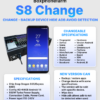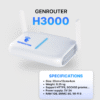In today’s internet world, security and privacy have become important issues. Anonymity and user protection tools such as open proxies were created to meet this need. The article below will provide you with an overview of open proxies, their definition, characteristics, advantages and disadvantages, as well as their applications. In addition, we will also explore frequently asked questions about what an open proxy is and provide instructions on how to disable them when necessary.
What is an open proxy?
An open proxy is a type of proxy server that allows data to be transmitted through it without requiring user authentication. It acts as an intermediary between the user and the destination website, hiding the user’s real IP address and helping to increase anonymity in cyberspace.
Open proxies are very useful when you want to access websites or online services without revealing your true identity. They are commonly used to bypass censorship, access geo-blocked sites, or avoid network monitoring (for example, at school or work).
However, open proxies also pose security and privacy risks. These servers are often not well-secured, so they can be exploited by hackers or used to collect user information. Therefore, it is essential to consider and use open proxies with caution.

Characteristics of an Open Proxy
An open proxy is a versatile server that serves many different purposes and offers many benefits to users. Below are the outstanding features of an open proxy:
- Anonymous web Browse: An open proxy helps users browse the web anonymously, protecting their online activities from being tracked.
- Bypassing internet filters: An open proxy allows users to access websites that are blocked in certain countries or regions, helping to overcome content restrictions.
- Downloading and sending large data: This type of proxy supports downloading large files or sending large amounts of data without being detected, while protecting the user’s privacy throughout the process.
- Hiding the IP address: An open proxy can conceal the user’s IP address, helping to access websites and services without being tracked.
Users should be aware of these characteristics when deciding whether to use an open proxy, and must choose carefully before using any proxy service.
Types of Open Proxy Servers
There are many types of open proxy servers, each serving different purposes and applications. Below are the common types of open proxy servers:
- HTTP Proxy: Using the HTTP (Hypertext Transfer Protocol), this proxy server forwards HTTP requests from the client to the server. An HTTP Proxy is often used to access blocked websites, improve web Browse performance, or browse the web anonymously.
- SOCKS Proxy: A SOCKS (Socket Secure) proxy server forwards network traffic from the client to the server. Similar to an HTTP Proxy, a SOCKS Proxy helps bypass IP address restrictions, improve performance, or secure web Browse.
- SSL Proxy: SSL (Secure Sockets Layer) proxy servers forward secure traffic between the client and the server. An SSL Proxy helps protect data during transmission and can be used to access blocked websites, while also improving performance or anonymity when Browse the web.
- NAT Proxy: A NAT (Network Address Translation) proxy server forwards traffic from a private network to a public network. A NAT Proxy helps bypass IP address restrictions, improve network performance, and support anonymous web Browse.
- Reverse Proxy: A reverse proxy server acts as a gateway between the Internet and web servers, receiving requests from the Internet and forwarding them to the origin server. A Reverse Proxy provides functions such as access control, caching, and load balancing.
- Anonymous Proxy: An anonymous proxy helps hide the user’s original IP address and replaces it with another IP address, helping to protect privacy when Browse the web.
- Transparent Proxy: A transparent proxy server still forwards the user’s original IP address to the service provider and can provide caching features.
- Distorting Proxy: A distorting proxy changes the user’s IP address to make it look like they are connecting from a different location.
- Elite Proxy: A high-anonymity proxy not only hides the original IP address but also changes the User-Agent header, helping to make the user appear as if they are connecting from a different device.
Depending on their needs and purpose of use, users can choose the appropriate type of open proxy to use effectively.

Pros and Cons of an Open Proxy Browser
Open proxies have many notable characteristics, both in terms of advantages and disadvantages, depending on the usage and needs of the user. Here are the main benefits and drawbacks of this type of proxy:
Advantages
Using an open proxy brings certain benefits to users, such as:
- Low cost: Open proxies are often free, helping users save on access costs, which is especially useful for those on a limited budget.
- Flexible accessibility: Open proxies help users bypass geographical restrictions or other network limitations. They can also assist in preventing Denial-of-Service (DDoS) attacks, helping to access websites and services faster than with a closed proxy.
- Enhanced security: Open proxies provide an additional layer of protection between the user and the Internet, helping to prevent malicious attacks. Routing traffic through an anonymous proxy helps users hide their IP address and location, making it harder for hackers to track them.
- Anonymity: Open proxies help hide the user’s IP address and location, making it more difficult to track the user’s activities. This is particularly beneficial for those who value personal privacy and security.
- Effective access control: Open proxies allow administrators to control access better than other types of proxies. Administrators can set specific access policies, block unwanted requests, and filter malicious traffic, helping to better secure the network and applications.
Disadvantages
Using an open proxy also comes with many risks that users need to consider:
- Security risks: Because anyone can access an open proxy, they can be abused to hide identities and carry out attacks such as DDoS, malware, and hacking.
- Resource abuse: Open proxies can be exploited to access restricted content, bypass geographical restrictions, or launch DDoS attacks against other networks, leading to resource abuse, slowing down, or even crashing the server.
- Privacy: Open proxies can be used to intercept and monitor user data and traffic, which can violate the user’s privacy.
- Legal issues: Using an open proxy to access restricted content or bypass geographical restrictions can lead to legal issues, especially if it violates copyright laws or other legal regulations.
- Limited accessibility: Open proxies are not always available and can be blocked by firewalls, making them unreliable for some activities. Furthermore, they can be overloaded or slow, reducing their effectiveness when fast access is needed.
Users should consider carefully and should not use open proxies for sensitive activities involving finance or security. In addition, be cautious with free proxy servers as they are likely to provide a poor experience and pose high-security risks.

Guide on How to Disable an Open Proxy
Disabling an open proxy helps minimize security risks. Below are instructions on how to disable the proxy in the Chrome browser:
On Windows
- Step 1: Click the three-dot icon in the top right corner of the browser.
- Step 2: Open the “Settings” tab.

- Step 3: Select “System”, then select “Open your computer’s proxy settings”.

- Step 4: In the “Automatic proxy setup” section, turn off the “Automatically detect settings” option.
- Step 5: In the “Manual proxy setup” section, turn off the “Use a proxy server” option.

- Step 6: Click “Save”.
On Mac
- Click the three-dot icon in the top right corner of the browser.
- Select “Settings”.
- Select “System”.
- Click “Open your computer’s proxy settings”.
- In the “Proxies” tab, uncheck all available options.
- Select “OK” to save the settings.
Additionally, you should also check the proxy configuration in each browser and application, and disable them if you detect any abnormalities. Regularly update your operating system, browser, and install antivirus software to prevent unauthorized proxy installations.

Some questions about open proxies
When using an open proxy, users may encounter problems related to IP address identification or blocking. Below are some common questions about open proxies and how to resolve them:
Why is your IP address flagged as an open proxy?
Your IP address may be flagged as an open proxy for the following reasons:
- Server misconfiguration: If your proxy server is configured incorrectly and allows unauthorized access, Internet Service Providers (ISPs), web services, online platforms, and security software may identify and flag your IP address as an open proxy.
- Malware or botnet infection: If your server device or network is infected with malware or is part of a botnet, the system may act as an open proxy. Cybercriminals may have taken control of your device and are using it for malicious activities.
- Previous usage history: If the IP address you are using has been previously associated with abusive online activities, it may have been flagged due to past unwanted behavior.
- Shared IP address: If you are using a shared network, such as public Wi-Fi, and share an IP address with many other users, the open proxy may be detected and flagged.
- Suspicious traffic patterns: If your IP address generates a large amount of traffic with the characteristics of an open proxy (e.g., a high number of connection requests), proxy detection tools may identify and flag your IP address.
How to detect an open proxy?
Organizations use various methods to detect open proxies. Below are some common methods:
- Port scanning: Tools or services scan a range of IP addresses to find open ports associated with open proxies.
- Traffic behavior analysis: Some systems monitor network traffic patterns to look for unusual characteristics, such as high traffic, a large number of connection requests, and abnormal proxy behavior.
- DNS query analysis: DNS requests related to the domain names of proxy services or anonymizing tools can generate alerts.
- Monitoring access logs and anomalies: Access logs from web servers and network devices can indicate unusual traffic patterns, such as one IP address making too many requests.
- Blocklists: Organizations maintain lists of open proxies and malicious IP addresses. Network administrators and security tools regularly check these lists to flag proxy-like IPs.
- Community reports: Users and network administrators can report suspicious IPs or behaviors that resemble proxies to organizations, helping to detect open proxies quickly.
How to determine if your IP is an open proxy?
To protect your online reputation and ensure the safety of your network, check and verify whether your IP address is an open proxy. Below are the steps to do this:
- Use an online proxy checker tool: Many online tools can help you determine if your IP address is flagged as an open proxy.
- Check reputable public IP lists: Look for reputable public IP lists or blocklists maintained by cybersecurity organizations and Internet Service Providers (ISPs) to check your IP address.
- Analyze your network traffic: Check network traffic patterns to detect unusual behaviors, such as high connection request frequencies or activities that indicate a proxy.
- Check server and proxy configuration: Ensure that your server and proxy are configured correctly to prevent them from acting as an open proxy.
- Contact your Internet Service Provider: If you believe your IP address has been incorrectly flagged, contact your ISP to request that your address be removed from the blacklist.

Open proxies are useful tools for anonymity and protecting privacy when accessing the internet, bypassing censorship, and geographical restrictions. However, they also pose many security risks. Users need to be cautious when using open proxies, especially for sensitive activities. In addition, for effective management of Phonefarm, Boxphone, Box phone Farm and to ensure account safety, GenFarmer is the leading solution. This platform helps automate, prevent account locks, and supports managing a large number of accounts across multiple platforms.











